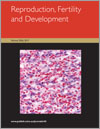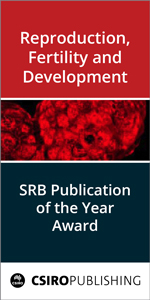Reproduction, Fertility and Development
Volume 29
Number 6 2017
Because carnitine treatment is used in many cases of male infertility, the aim of the present study was to evaluate the mechanism by which carnitine improves spermatogenesis in mice. In the study, carnitine treatment of mice stimulated peroxisome proliferator-activated receptor-γ coactivator-1α expression, which, in turn, regulated steroidogenesis by enhancing expression of Bcl2 and antioxidant enzymes in the testis.
Removal of protein from culture medium improves analytical reliability, although bovine embryo development in vitro could be affected. However, protein removal over a 24-h period in culture led to embryos with reduced miscarriage rates without affecting birthweight, gestation length or calf morphology. This finding represents direct access to culture medium as a substrate for non-invasive analysis, leading to potential biomarker discovery without compromising embryonic viability.
Preventing spontaneous preterm birth, which is the leading cause of perinatal mortality and morbidity, is one of the most important issues facing perinatal medicine today. In this study, we found that spontaneous labour is associated with an increase in optineurin (OPTN) expression in fetal membranes and the myometrium, where it functions as a negative regulator of prolabour mediators. Elucidating the role of OPTN in labour processes enhances our understanding of the mechanisms that drive preterm birth and could perhaps lead to the development of a clinical therapeutic strategy.
Early development of the equine embryo occurs in the oviduct, and information on the composition of this oviducal environment is very valuable. We identified the proteins in the oviducal fluid of the horse, and proteins that are important for pregnancy were found in higher amounts when an equine embryo was present. These findings provide a solid basis for further studies on embryo–maternal interactions in the horse.
Prediction of breeding bull fertility is of major economic value to the cattle-breeding industry. We proved that spermatozoa from high-fertile bulls showed a low degree of tyrosine phosphorylation and high degree of capacitation and acrosome reaction upon exposure to oviductal fluid. These findings may help in developing tools for assessing fertility of bulls, once validated in more animals.
Sperm freezing has advanced animal breeding and genetics in numerous species but is not successful in alpacas due to the gel-like nature of the semen. This research aimed to reduce the viscosity of alpaca semen without affecting sperm function. The enzyme papain (0.1 mg mL–1 for 20 min at 37°C) followed by the papain inhibitor E-64 (10 µm for 5min at 37°C) eliminated viscosity and aided cryopreservation of alpaca spermatozoa. These findings will help to advance the use of reproductive technologies in camelids.
Progesterone is a steroid present in the female reproductive tract that aids sperm motility. In the present study we identified human sperm proteins that are modified in response to progesterone and propose a mechanism by which progesterone would aid motility. This information may be useful for the development of drugs to improve sperm motility and contraceptives.
Fipronil, an insecticide widely used in agriculture, veterinary medicine and public health, has been listed as a potential endocrine disrupter. The present study showed that fipronil can affect the sperm motility and compromise sperm quality of the animals. The perinatal exposure to fipronil has long-term effects on sperm parameters, and the epididymis can be a target organ.
Investigations into the relationship between FSH and anti-Müllerian hormone (AMH) during in vitro culture of isolated preantral follicles are lacking. The aim of the present study was to evaluate the effect of AMH, with and without FSH, on the in vitro development of isolated caprine follicles. We demonstrated that AMH reduces follicular growth without altering follicular survival. Thus, AMH may play an important role in regulating the growth of caprine preantral follicles.
The occurrence of intrauterine growth restriction is linked to a plethora of non-communicable disorders during postnatal life. Our study, using a translational swine model, provides evidence that prenatal developmental is strongly modulated by fetal genotype and sex. Such findings stress the necessity for considering ethnicity and sex effects in the study of the developmental origins of adult health and disease.
The effect of cytokines on human male fertility is attracting more attention. In this in vitro study, the effects of TNF-α and its antagonist, etanercept, in ejaculated human spermatozoa were analysed. The negative influence of TNF-α on sperm function and the positive action of etanercept were demonstrated. This data may have clinical relevance for the management of chronic inflammatory diseases related to male reproduction.
Feasibility of luteal phase ovarian stimulation has already be certified in poor ovarian responders. Embryos produced during the luteal phase resulted in higher implantation rates compared with those produced during the follicular phase. Luteal phase ovarian stimulation should be recommended for poor ovarian responders.
High temperatures are correlated with reduced fertility. Ovarian function in pseudopregnant rats was determined in a laboratory setting of repeated heat stress. Heat stress altered the activity of mitogen-activated protein kinases and the expression of heat shock protein 70 and activating transcription factor 3 in the corpus luteum. A deeper understanding of the effects of heat stress on ovarian function will enable better approaches to promote female fecundity and sustainable animal production.
The prominin-1 protein has previously been broadly investigated for its potential role in cancer and stem cell biology. This is the first investigation into the role of prominin-1 in early pregnancy. The study localises prominin-1 to the apical region of uterine epithelial cells and shows that maternal ovarian hormones significantly affect the glycosylation and abundance of this protein.
ISG15 mRNA exists in bovine embryo from one cell stage, which is earlier than IFNT mRNA. When the expression of ISG15 was knockdown, the development of blastocyst was negatively affected, , and the expressions of Ets2, IFNT and connexion 43 were inhibited in bovine blastocysts.
In this study we evaluated the effect of feeding oocyte donor beef heifers with a protected fat enriched in linoleic acid on embryonic developmental rates after IVF, embryo cryotolerance and the membrane lipid composition of fresh and vitrified–warmed embryos. Although embryo yield, cryotolerance and membrane lipid profile were unaffected by dietary supplementation, the membrane lipid profile was affected by the cryopreservation process. Because the lipid ion abundances of fresh and vitrified–warmed embryos were distinct, they can be used as potential markers of post-cryopreservation embryonic survival.
Vitamin D deficiency has been linked to impaired pubertal development affecting reproductive physiology. The effects of vitamin D3 were investigated on the juvenile gonadotrophin-releasing hormone (GnRH) neuron, a central regulator of the hypothalamic–pituitary–gonadal axis. Exposure to vitamin D3 suppressed the N-methyl-D-aspartate and kainate-mediated responses of juvenile GnRH neurons. We suggest that vitamin D is essential for normal and timely functioning of pubertal development.
Current treatments for intrauterine growth restriction are not particularly effective. Sildenafil citrate (SC), a vasodilator and angiogenic molecule, could be an option to enhance conceptus growth. Here we studied, in a rabbit model, whether the administration of SC could improve or ameliorate diet-induced defects in conceptus development and offspring outcome. SC seems to benefit pregnancies complicated by placental insufficiency; however, further research is needed.
For the first time the presence and localisation of AQP3 and AQP7 in bull spermatozoa was determined, together with their relationship to sperm cryotolerance. Our findings show that neither the relative amounts nor the localisation of these proteins was altered by cryopreservation procedures. Furthermore, the abundance of AQP7 in fresh semen was found to predict bull sperm cryotolerance.
Somatic cell nuclear transfer is frequently associated with abnormal epigenetic modifications. The present study investigated the effects of BIX-01294 on cloned mouse preimplantation embryos and the results indicated that BIX-01294 treatment of cloned embryos has beneficial effects in terms of correcting abnormal epigenetic modifications. It will be investigated further whether BIX may affect postimplantation development by correcting epigenetic modifications.




